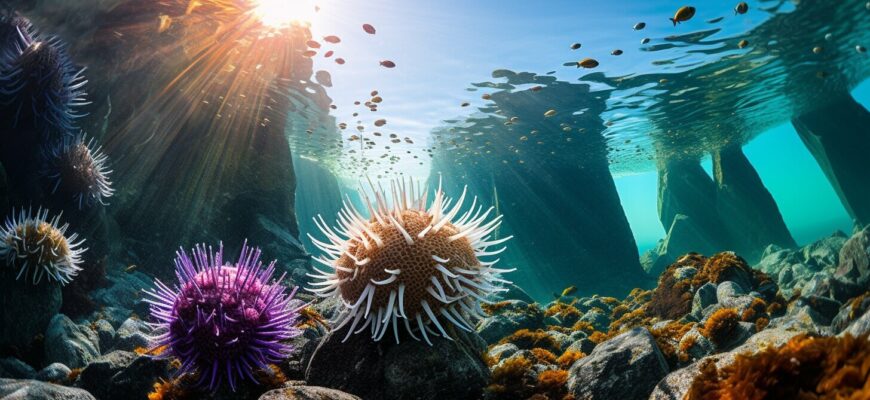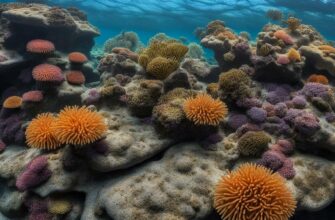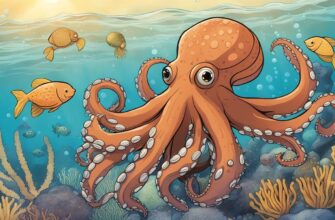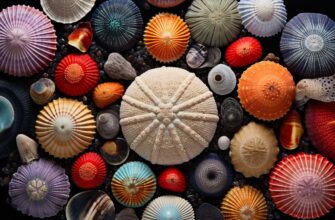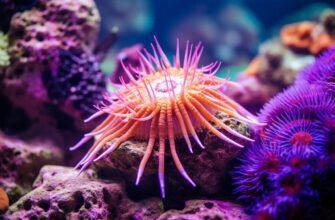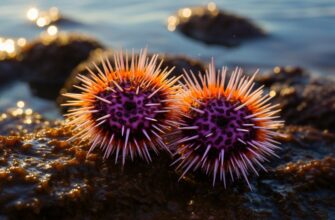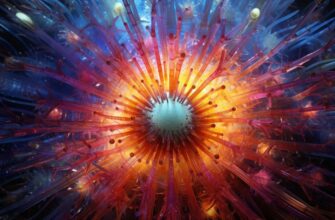Have you ever wondered if sea urchins are alive? Although they may not seem like the typical living creatures you encounter on land, sea urchins are indeed alive marine animals.
These fascinating creatures are found in oceans all around the world, ranging from shallow coastal waters to deep-sea environments. They come in a variety of shapes, sizes, and colors, and are known for their spiny exteriors.
In this article, we will explore the world of sea urchins, beginning with whether they are alive or not. We will provide a clear answer and take you on a journey to discover the unique characteristics and ecological importance of these marine creatures.
- The Life Cycle of Sea Urchins
- Stage 1: The Larval Stage
- Stage 2: The Juvenile Stage
- Stage 3: The Adult Stage
- Physical Characteristics of Sea Urchins
- Spines
- Anatomy
- Variations in Shape and Color
- Adaptations and Survival Strategies of Sea Urchins
- Protective Spines
- Tube Feet
- Flexible Diets
- Habitat Selection
- Regeneration
- Ecological Importance of Sea Urchins
- Kelp Forests
- Coral Reefs
- Biodiversity
- Frequently Asked Questions about Sea Urchins
- Can you touch a sea urchin?
- Are sea urchins poisonous?
- What do sea urchins eat?
- How do sea urchins defend themselves?
- Can sea urchins swim?
- What is the lifespan of a sea urchin?
- How do sea urchins reproduce?
- What is the ecological importance of sea urchins?
The Life Cycle of Sea Urchins
Sea urchins have a fascinating life cycle, which includes several distinct stages. These stages are crucial for their growth and development, as they transform from tiny larvae into fully mature adults.
Stage 1: The Larval Stage
Sea urchin larvae are microscopic and drift with the ocean currents, feeding on plankton. During this stage, they undergo a process called metamorphosis, where they transform into a juvenile form. This involves developing the characteristic spiny exterior that sea urchins are known for.
Stage 2: The Juvenile Stage
As the larvae transform into juveniles, their spiny exterior becomes more pronounced, and they begin to develop the tube feet and mouth that they will use for feeding. They continue to feed on plankton and algae during this stage, growing quickly in size.
Stage 3: The Adult Stage
Once they have reached adulthood, sea urchins are fully formed and can reproduce. They continue to feed on algae and other small organisms, using their specialized mouthparts and spines to find and capture food.
Reproduction typically involves the release of eggs and sperm into the water, where they will fertilize and develop into larvae. The life cycle of sea urchins is a remarkable process that underscores their resilience and adaptability in marine environments.
Physical Characteristics of Sea Urchins
Sea urchins are fascinating marine creatures with a variety of physical characteristics that make them distinctive. Their most notable feature is their spiny exterior, which helps protect them from predators and provides a means of defense.
Aside from their spines, sea urchins have a round or oval-shaped body with five-fold symmetry, giving them a distinctive star-like appearance. Their mouth is located on the bottom of their body, and they have a complex internal anatomy that includes a water vascular system and a digestive system.
Sea urchins come in a range of colors, from bright purple and red to more subdued browns and greens. Some species even have patterns or markings on their body. The shape of their body can also vary depending on the species, with some being more spherical and others being more flattened.
Spines
The spines of sea urchins are one of their most distinctive features, and they come in a variety of shapes and sizes depending on the species. Some species have long, thin spines while others have shorter, thicker ones.
These spines serve a variety of purposes for the sea urchin. They help protect the sea urchin from predators, deter other animals from trying to eat them, and can even be used to grip onto surfaces to prevent them from being swept away by ocean currents.
Anatomy
The internal anatomy of a sea urchin is intricate and complex. They have a water vascular system that is used to help them move and feed. This system includes tube feet, which are used for locomotion and grasping onto surfaces.
Sea urchins also have a digestive system that is responsible for breaking down their food and extracting nutrients. The mouth of a sea urchin is located on the bottom of their body, and they have specialized teeth that are used to scrape algae and other food off of rocks and other surfaces.
Variations in Shape and Color
Sea urchins come in a wide range of shapes and colors depending on the species. Some have a spherical body shape while others are more flattened. Some have longer spines while others have shorter, thicker ones.
Colors can also vary widely, with some species being brightly colored while others are more subdued. Certain species even have patterns or markings on their bodies.
Overall, sea urchins are a fascinating group of marine animals with a variety of unique physical characteristics that make them stand out from other creatures in their ecosystem.
Adaptations and Survival Strategies of Sea Urchins
Sea urchins have developed various adaptations that help them survive in their marine habitats. These adaptations are essential for their protection against predators and ensure their access to food.
Protective Spines
One of the most prominent adaptations of sea urchins is their spiny exterior. These spines are not only a physical deterrent to predators but also are used for movement and holding onto surfaces. Some species even have venomous spines that can cause irritation or pain to predators or humans who come into contact with them.
Tube Feet
Another adaptation of sea urchins is their tube feet, which protrude from the underside of their bodies. These tube feet are used for movement and help them cling to rocks and other surfaces. They also use their tube feet for feeding by grasping onto prey and bringing it to their mouth.
Flexible Diets
Sea urchins are omnivores and have a flexible diet that allows them to survive in different environments. Some species feed primarily on algae, while others feed on small invertebrates. This adaptability allows sea urchins to survive even when food sources are scarce.
Habitat Selection
Sea urchins have evolved to thrive in a variety of marine habitats. Some species prefer rocky areas with strong currents, while others are found in sandy or muddy areas. By selecting their habitats carefully, sea urchins can increase their chances of survival.
Regeneration
One of the most remarkable adaptations of sea urchins is their ability to regenerate lost limbs or spines. This allows them to recover from injuries caused by predators or other environmental factors. Some species can even regrow an entire new body from a single arm or disk.
“The spiny exterior and tube feet are essential for the survival of sea urchins. Such adaptations protect them from predators and ensure that they can find food effectively.”
Ecological Importance of Sea Urchins
Sea urchins are not just interesting creatures, but they also play a significant ecological role in marine ecosystems. Here are some ways sea urchins contribute to maintaining the balance of the ocean’s biodiversity:
Kelp Forests
Sea urchins are known for their appetite for kelp, a type of seaweed that forms dense underwater forests. Without the presence of sea urchins, kelp forests can become overgrown and choked with debris, reducing the availability of food and shelter for other marine animals. By grazing on kelp, sea urchins keep its growth in check, allowing for a healthy and diverse ecosystem that supports a variety of species.
Coral Reefs
Sea urchins also play a role in the protection of coral reefs, which are important habitats for many marine animals. Sea urchins graze on algae that compete with benthic (bottom-dwelling) organisms, including coral. This grazing activity creates spaces for coral to grow and thrive, ultimately enhancing the health and biodiversity of the reef.
Biodiversity
The presence of sea urchins can promote biodiversity in marine ecosystems. By controlling the growth of specific species, they create space and opportunity for others to flourish. For instance, in areas where sea urchins are abundant, researchers have observed a greater diversity of mollusks, echinoderms (such as starfish), and other invertebrate species.
In conclusion, sea urchins are more than just interesting creatures with unique physical characteristics. Their role in maintaining the balance of kelp forests and coral reefs, and their impact on biodiversity, make them an important part of marine ecosystems. As such, it’s important that we continue to learn about and protect these fascinating animals.
Frequently Asked Questions about Sea Urchins
Sea urchins are fascinating creatures that are often misunderstood. In this section, we will address some common questions and concerns regarding sea urchins.
Can you touch a sea urchin?
It is generally not recommended to touch a sea urchin, as their spines can be sharp and painful. However, if you do need to handle a sea urchin, it is best to wear gloves or use a towel to protect your hands.
Are sea urchins poisonous?
While some sea urchins do contain toxins that can be harmful to humans, most sea urchin species are not considered poisonous. However, it is always best to avoid contact with sea urchins as a precautionary measure.
What do sea urchins eat?
Sea urchins are herbivores and primarily feed on algae and other marine plants. They use their specialized mouthparts to scrape and break down their food.
How do sea urchins defend themselves?
Sea urchins have a variety of defense mechanisms, including their sharp spines and tube feet that allow them to clamp onto surfaces. Some species also have toxins in their spines that can deter predators.
Can sea urchins swim?
While sea urchins cannot swim in the traditional sense, they do have the ability to move using their tube feet. They can also use their spines to roll or crawl short distances.
What is the lifespan of a sea urchin?
The lifespan of a sea urchin varies depending on the species, but ranges from 5 to 70 years.
How do sea urchins reproduce?
Sea urchins reproduce through external fertilization, where eggs and sperm are released into the water. The fertilized eggs develop into larvae, which eventually settle on the ocean floor and grow into adult sea urchins.
What is the ecological importance of sea urchins?
Sea urchins play a crucial role in maintaining the balance of marine ecosystems. They help to control the growth of algae and other marine plants, which can have a major impact on the health of coral reefs and kelp forests.

